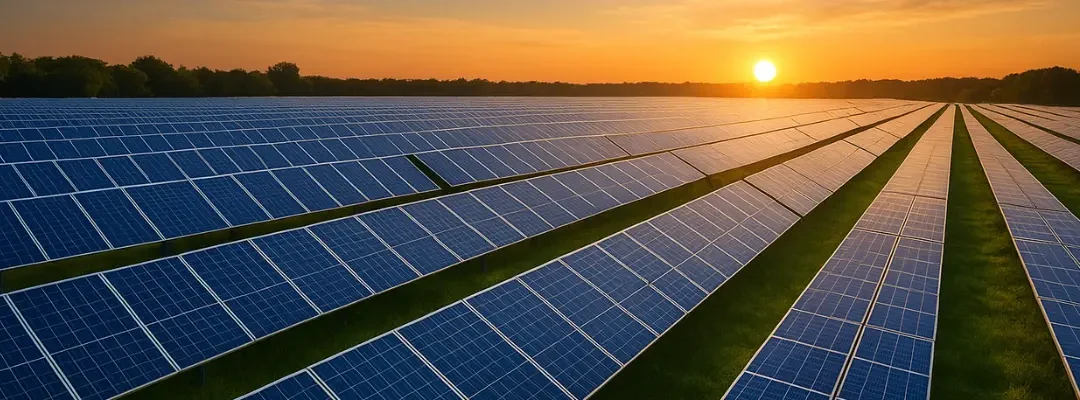Introduction
India is undergoing an energy revolution, with renewable power at the center of its growth story. Among all clean energy options, solar energy parks have emerged as the biggest driver of large-scale transformation. With India targeting 500 GW of renewable energy by 2030, solar parks are set to play a defining role.
For entrepreneurs, developers, and investors, this sector represents not only a chance to support sustainability but also to tap into highly profitable opportunities. Let’s explore why solar energy parks are the future and how entrepreneurs can benefit from them.
What Are Solar Energy Parks?
A solar energy park is a large piece of land where multiple solar power projects are developed, often ranging from megawatt (MW) to gigawatt (GW) scale.
- Unlike rooftop solar, which powers homes or societies, solar parks are designed for large-scale generation.
- Power generated is fed into the grid, supplying electricity to industries, businesses, or government utilities.
- They often involve land aggregation, government support, and long-term power purchase agreements (PPAs).
In simple words: A solar park is like an industrial hub for electricity, but powered by the sun.
Why Solar Energy Parks Are the Future of Power in India
- National Renewable Targets – India aims to install 500 GW of renewable power by 2030, with solar taking the lion’s share.
- Industrial Demand – Corporates and SMEs are increasingly committing to 100% green energy for sustainability and cost reasons.
- Government Push – Schemes like the MNRE Solar Park Scheme and state-level renewable policies are actively encouraging solar park development.
- Climate Goals – Solar parks help India meet its Paris Agreement and net-zero commitments.
In short: Solar parks are not just an energy project; they are part of India’s national growth and climate strategy.
The Investment Opportunity for Entrepreneurs
For entrepreneurs, solar parks open doors to multiple business opportunities:
- Power Generation Projects
- Set up MW-scale plants and sell electricity through PPAs to DISCOMs or corporates.
- Earn predictable revenue streams for 20–25 years.
- Land Aggregation & Leasing
- Buy or consolidate agricultural land and lease it to solar developers.
- Profitable for entrepreneurs and beneficial for farmers.
- EPC & O&M Services
- Engineering, Procurement & Construction (EPC) and long-term maintenance services are in high demand.
- ROI Potential
- Solar parks typically deliver 20–25% ROI annually.
- Safer compared to volatile investments like stocks.
Key Benefits of Investing in Solar Parks
- Stable and Recurring Income – PPAs lock in tariffs for 15–25 years.
- Government Incentives – Subsidies, viability gap funding (VGF), and tax benefits.
- Low Operating Costs – After installation, solar systems require minimal maintenance.
- Sustainability Edge – Entrepreneurs can attract ESG-focused investors.
- Job Creation – Solar parks create employment in rural areas, building goodwill.
Challenges Entrepreneurs Should Know
Like any sector, solar parks also come with challenges:
- Land Acquisition Issues – Title disputes, fragmented ownership, or unclear records.
- Tariff Risks – Some DISCOMs delay payments or renegotiate tariffs.
- Grid Bottlenecks – Evacuation infrastructure may not always match solar park capacity.
- Upfront Investment – MW-scale projects require significant capital.
Solution: Work with experienced EPCs, land aggregators, and legal advisors to reduce risks.
Case Studies of Successful Solar Parks
Bhadla Solar Park, Rajasthan
- World’s largest solar park with 2,245 MW capacity.
- Spans 14,000 acres in the Thar Desert.
- Powers millions of homes while providing long-term returns to investors.
Charanka Solar Park, Gujarat
- India’s first large-scale solar park (590 MW+).
- Attracted entrepreneurs, land aggregators, and global investors.
- Set the foundation for India’s solar park policy.
Future Outlook: Why Now Is the Right Time
- Declining Costs – Solar panel costs have dropped over 80% in the last decade.
- Hybrid Models – Solar + Wind + Storage projects are gaining traction.
- Green Hydrogen Push – Solar parks will fuel India’s hydrogen economy.
- Policy Support – 500 GW by 2030 = massive opportunities for developers and entrepreneurs.
Waiting means missing out on the early-mover advantage
Conclusion
Solar energy parks are no longer an experimental idea — they are the future of power generation in India. For entrepreneurs, they offer a rare mix of profitability, stability, and sustainability.

